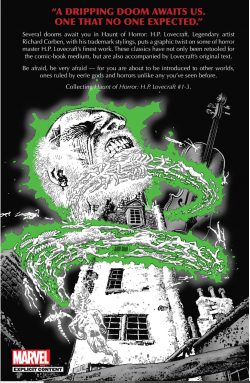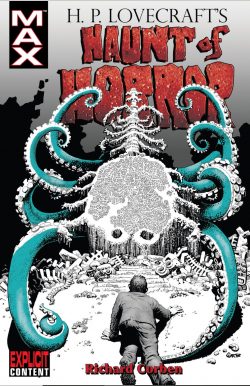

By H.P. Lovecraft adapted by Richard Corben with Jeff Eckleberry (MARVEL MAX)
ISBN: 978-0-7851-3287-5 (HB/Digital edition)
Richard Corben was one of America’s greatest proponents of graphic narrative: an animator, illustrator, publisher and cartoonist, who sprang from the tumultuous wave of independent counterculture commix of the 1960s and 1970s to become a major force in graphic narrative storytelling with his own unmistakable style and vision.
He is equally renowned for his mastery of airbrush, captivatingly excessive anatomical stylisation and delightfully wicked, darkly comedic horror, fantasy and science fiction tales. In later years he has become an elder statesman of horror and fantasy comics lending his gifts and cachet to such icons as John Constantine, Hulk, Hellboy, Punisher and Ghost Rider as well as new adaptations and renditions of literary classics by the likes of William Hope Hodgson, and the master of gothic terror Edgar Allan Poe.
Corben never sold out and American publishing eventually caught up, finally growing mature enough to accommodate him – due in no small part to his own broad and wickedly pervasive influence…
Born in Anderson, Missouri in 1940, Corben graduated with a Fine Arts degree in 1965 and found work as an animator. At that time, the neutered comic books of the Comics Code Authority era were just starting to lose disaffected, malcontent older fans to the hippy-trippy, freewheeling, anything-goes publications of independent-minded creators across the continent. These folks were increasingly making the kind of material Preachers and Mummy and their Lawyers wouldn’t approve of…
Creativity honed by the resplendent and explicitly mature 1950s EC Comics, Carl Barks’ perfectly crafted Duck tales and other classy early strips, a plethora of young artists like Corben responded with numerous small-press publications – including Grim Wit, Skull, Slow Death, Fever Dreams and his own Fantagor – which featured shocking, rebellious, sexed-up, raw, brutal, psychedelically-inspired cartoons and strips blending the new wave of artists’ unconventional lifestyles with their earliest childhood influences… honestly crafting the kind of stories they would like to read.
Corben inevitably graduated to more professional – and paying – venues. As his style and skills developed, he worked for Warren Publishing in Eerie, Creepy, Vampirella, Comix International and outrageous adult science fiction anthology 1984/1994. He also famously coloured some strips for the revival of Will Eisner’s The Spirit.
Soon after, he was producing stunning graphic escapades for a number of companies, making animated movies, painting film posters and producing record covers such as multi-million-selling album Bat Out of Hell. He never stopped creating comics but preferred personal independent projects or working with in-tune collaborators such as Bruce Jones, Jan Strnad and Harlan Ellison.
In 1975, Corben approached French fantasy phenomenon Métal Hurlant and quickly became a fixture of its American iteration Heavy Metal, cementing his international reputation in the process. Garnering huge support and acclaim in Europe, he was been regularly collected in luxurious albums even as he seemingly fell out of favour – and print – in his own country. Through it all he never strayed far from his moss-covered roots.
Corben died in 2020.
This particular tome gathers a 2007 return to adaptations of classic literary horror canon. First published as a 3-issue limited series, it features adaptations of poems and stories by an undisputed master of supernal terror: H.P. Lovecraft. The tales are radical reworkings of the troubled author’s works, rendered in line and gray-tones, and each sequential narrative reinterpretation is accompanied by its original prose iteration.
Howard Phillips Lovecraft was born in August 1890 in Providence, Rhode Island and his life in New England was one of gradual loss and despair. His father was institutionalised when he young, and a comfortable life of wealth ended when his grandfather died. Enduring privation, he lost his mother to another asylum in 1919. He married in 1924 after moving to New York, where his writing for Weird Tales and other pulp fiction magazines drew acclaim – and even acolytes – but little by way of commercial security.
He returned to New England in 1926 and wrote ever more fevered and chilling tales of weird science, fantasy and horror fiction. In the next 11 years he penned some of the most disturbing stories in literature, centred around his belief in Civilizational decline and Cosmicism: affirming the insignificance of humanity and its ultimate fragility and inability to endure in a harsh, unforgiving universe.
He is best remembered today for his Cthulhu Mythos: an elder god cosmology as seen in The Call of Cthulhu and other stories.
Lovecraft died in 1937 as a result of stomach cancer.
This selection of speculative meanderings opens with ‘Dagon’, as an ailing and oppressed marine researcher records how a close call with a German U-boat catapulted him onto a lost isle of monsters and ancient artefacts, and forever marked him as prey for an indescribable horror. The original prose vignette follows, after which ‘The Scar’ tells of betrayal and abandonment as a young man opts to save himself but not his companion from hellish plants: – a grisly episode eerily expanded upon from the poem ‘Recognition’ as collected in the tome Fungi from Yuggoth.
From the same book comes both the poem ‘A Memory’ and chilling icy exploration as Jack searches the desolate region that claimed his father and finds a relic that that dooms him via fatal family connection to lost and malign cultists of Shub Niggurath…
The second issue began with ‘The Music of Erich Zann’, as an impoverished student recalls how long ago he lived in a hilltop hovel where an elderly fellow boarder played bizarre melodies that shook the world and summoned arcane atrocities before – again bordered by a text version – another extract from Fungi from Yuggoth finds a flood survivor desperately searching for her lost love in the body-packed detritus of ‘The Canal’…
Sticking with the bulletins from Yuggoth, ‘The Lamp’ focuses on an unexpected and angry archaeological breakthrough that is alive and hungry after four millennia, before the final issue opens with extended scary satire ‘Arthur Jermyn’ and thereafter its primary text ‘Facts Concerning the Late Arthur Jermyn and His Family’. In a wry change of pace, it traces – via his proud descendants -the history and heritage of a gentleman explorer and anthropologist who in 1750 discovered a lost kingdom and injected some new blood into an old, old race.
Of course the miscegenation has resulted in some few throwbacks and anomalies in the hallowed English lineage since then…
Another ravening predator inhabits ‘The Well’ foolishly dug by southern farmer Seth Atwood, one using love and thirst to draw in victims, and our last glimpse of the outer dark comes through ‘The Window’ of a desolate old house as an orphan son returns to discover what took his parents 25 years ago…
A potent and evocative peep into the nastiest places in creation, this collection also includes ‘Cover Sketches’ and ‘Promotional Images’, plus a selection of inked pages prior to the application of the cloaking grey tones.
Infamous for his dark, doom-laden horror stories, Lovecraft was a pioneer of the subgenre of supernal, inescapable terror and under Corben’s imaginative scrutiny, the grim gloomy odes and yarns take on a whole new level of distressing dissonance. This compelling collection of classic chillers is a modern masterpiece of arcane abomination and inhuman horror no shock addict of mystery lover will want to miss.
© 2020 MARVEL.
